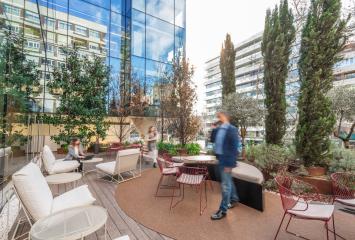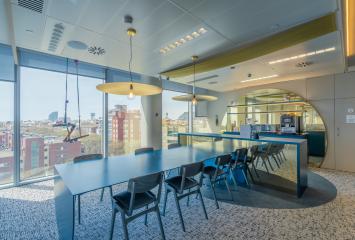Green Roofs and their environmental benefits
For years, construction has been implementing sustainability criteria in all processes, with the aim of creating sustainable buildings that improve cities and people's lives. One of the options gaining popularity day by day is extensive green roofs, a way of integrating vegetation into buildings that also brings great benefits to the people, species and environment.
At Colonial, we implemented more than 650m² of extensive and semi-extensive green roofs on our buildings in 2019 and 2020, with the advice of MACE. Our goal was to mitigate some of the major climate risks we are exposed to due to the growth of the urban footprint, such as the extinction of pollinators, increase of temperature in cities due to the heat island effect, desertification of territories, increase of respiratory and psycho-physical diseases in the urban population, etc.
In today's blog, we will talk about the characteristics of these roofs on our assets and their benefits for the environment.
Buildings promoting Biodiversity in Barcelona
The Dau building is located on Avenida Diagonal, very close to Plaça de la Reina Maria Cristina. This area is identified as an ecological corridor, as it links the semi-naturalized area of Montjuic with the Collserola Natural Park. Key flora species for the city's ecosystems have been planted on the roof of the building to increase the biodiversity of the environment through colonization by species of higher ecological quality. On the other hand, fruit-bearing species have also been planted, since they serve as a source of sustenance for the fauna of the area, mainly birds and insects. Finally, aromatic species have been put in the building, which fulfill two different functions: first, they support pollinators and, second, they secrete mosquito-repellent substances.
A little further away from the city of Barcelona, but located to the north of the metropolitan area of the city, we find the Sant Cugat Nord building complex, which is located in an exclusive environment, with numerous wooded areas around it and with a high biodiversity value. In the landscaped areas, nesting boxes were installed in the trees to promote the species of bats that live in the area. In addition, "insect hotels" have also been built to protect particularly vulnerable insect species. In this case, fruiting, aromatic and key plant species were also planted to increase biodiversity.
Biodiversity building in Madrid and its relation to other benefits
Our Discovery Building is an example of a building that promotes sustainability and that, in turn, links with other buildings to do so. On its roof, plant and aromatic species have been installed through a 74m² vegetable roof, also including a vertical garden. In addition, it is directly connected to the building located at Poeta Joan Maragall, 53, and to the one at Castellana 163. This relationship aims to protect the populations of pollinating insects, which are declining worldwide, and which serve as a source of food for birds, playing a fundamental role in maintaining the biodiversity of the botany.
These are just some of the examples we have developed in Colonial's portfolio, thanks to the collaboration with the consulting firm Mace, with whom we have designed measures that promote an improvement in biodiversity in our buildings and, in turn, are committed to creating better cities and more environmentally responsible buildings.

